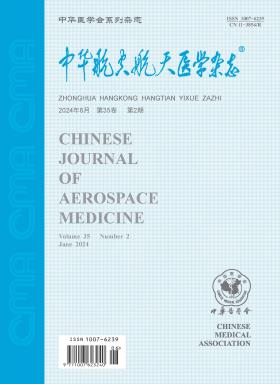Research on the simulation method of experiencing night myopia on the ground
引用次数: 0
Abstract
Objective To establish a simulation method that enables pilots to experience night myopia and help them to improve the understanding of it and its hazards to flight safety. Methods The self-made visual object was a 2 mm-diameter light emitting diode (LED) lamp with controllable luminous intensity. Twenty volunteers with normal vision (≥1.0) were asked to search the target light 6 m away as they adapted the environment in a standard dark room for 20 min. The subjects were guided to slowly move (10-20 cm/s) toward the target light until they saw it. The moment of seeing the object target light was marked as time A and the distance between visual object and subject was marked as LA. Then the subject was asked to stare at the target light and slowly moved apart from the target light until he/she couldn't see it. The target losing moment was marked as time B and the distance between target light and subject was marked as LB. Tobiipro Glass Ⅱ was used to record eye movements and pupil changes in real time. A manual optometry screening instrument (SW-800) was used to detect the refractive diopter under normal indoor lighting condition and the refractive diopters at time A and time B. The degree of night myopia was calculated according to the refractive diopter change and the displacement between LA and LB (LAB). The effects of the luminance of the target light (low: 1×10-3 cd/m2, medium: 2×10-3 cd/m2, high: 3×10-3 cd/m2) and the correction of negative spherical lens (+ 0.5 D and + 1 D) on the experimental results were analyzed. One-way analysis of variance was used for statistical analysis. Results The subjects, diopter was respectively (-0.194±0.390)D, (-0.509±0.532)D and (-0.836±0.700)D corresponding to under normal luminance, at time A and at time B. The significance was observed among these 3 conditions (F=6.679, P<0.01). The record of eye movement was consistent with the subject's report. Subject's pupil tended to dilate as soon as the target light was seen. When subjects wore + 1 D spherical correction lens, the results indicated longer LA and shorter LAB comparing to the unaided observation (P<0.05). The LAB under medium and high luminance target light was significantly shorter than that under low luminance (P<0.05). Conclusions This method can effectively simulate night myopia effect and assess the myopia, improve the understanding of night myopia, and is suggested to apply to pilot's experience in ground training. Key words: Myopia; Refraction, ocular; Dark focus; Ambient luminance; Night; Simulation地面体验夜间近视的模拟方法研究
目的建立一种飞行员体验夜间近视的模拟方法,帮助飞行员提高对夜间近视及其对飞行安全危害的认识。方法自制视物为直径2 mm的发光二极管(LED)灯,发光强度可控。20名视力正常(≥1.0)的志愿者在标准暗室中适应环境,寻找6米外的目标光源20分钟。受试者被引导缓慢移动(10-20厘米/秒),直到他们看到目标光源。看到物体目标光的瞬间记为时间A,视觉物体与被试之间的距离记为LA。然后受试者被要求盯着目标光,慢慢地远离目标光,直到看不见为止。目标丢失时刻记为时间B,目标光与被试的距离记为LB。使用Tobiipro GlassⅡ实时记录眼球运动和瞳孔变化。采用人工验光筛检仪(SW-800)检测患者在室内正常光照条件下的屈光度和A、b时刻的屈光度,根据屈光度变化及LA与LB (LAB)之间的位移计算夜间近视程度。分析了目标光亮度(低:1×10-3 cd/m2,中:2×10-3 cd/m2,高:3×10-3 cd/m2)和负球面透镜校正(+ 0.5 D和+ 1 D)对实验结果的影响。统计分析采用单因素方差分析。结果受试者在正常亮度下、A时刻和b时刻的屈光度分别为(-0.194±0.390)D、(-0.509±0.532)D和(-0.836±0.700)D,三者间差异有统计学意义(F=6.679, P<0.01)。眼球运动的记录与受试者的报告一致。目标光一出现,实验对象的瞳孔就会放大。当受试者佩戴+ 1 D球面矫正镜时,与单独观察相比,LA延长,LAB缩短(P<0.05)。中、高亮度靶光下的LAB显著短于低亮度靶光下(P<0.05)。结论该方法能有效模拟夜间近视效果并对近视进行评估,提高对夜间近视的认识,建议应用于飞行员地面训练经验。关键词:近视;折射,眼部;黑暗的焦点;环境亮度;晚上;模拟
本文章由计算机程序翻译,如有差异,请以英文原文为准。
求助全文
约1分钟内获得全文
求助全文
来源期刊

中华航空航天医学杂志
航空航天医学
自引率
0.00%
发文量
2962
期刊介绍:
The aim of Chinese Journal of Aerospace Medicine is to combine theory and practice, improve and popularize, actively advocate a hundred flowers bloom and a hundred schools of thought contend, advocate seeking truth from facts, promote the development of the related disciplines of aerospace medicine and human efficiency, and promote the exchange and penetration of aerospace medicine and human efficiency with other biomedical and engineering specialties.
Topics of interest for Chinese Journal of Aerospace Medicine include:
-The content of the journal belongs to the discipline of special medicine and military medicine, with the characteristics of multidisciplinary synthesis and cross-penetration, and mainly reflected in the aerospace industry, aerospace flight safety and efficiency, as well as the synthesis of special medicine, preventive medicine, environmental medicine, psychology, etc.
-Military aeromedicine (Air Force, Navy and Army aeromedicine) and civil aeromedicine, with a balance of aerospace medicine are the strengths of the journal.
-The change in aerospace medicine from a focus on promoting physiological compensatory adaptations to enhancing human performance under extreme environmental conditions is what the journal is helping to promote.
-The expansion of manuscripts in high altitude medicine is also a special emphasis of the journal.
 求助内容:
求助内容: 应助结果提醒方式:
应助结果提醒方式:


